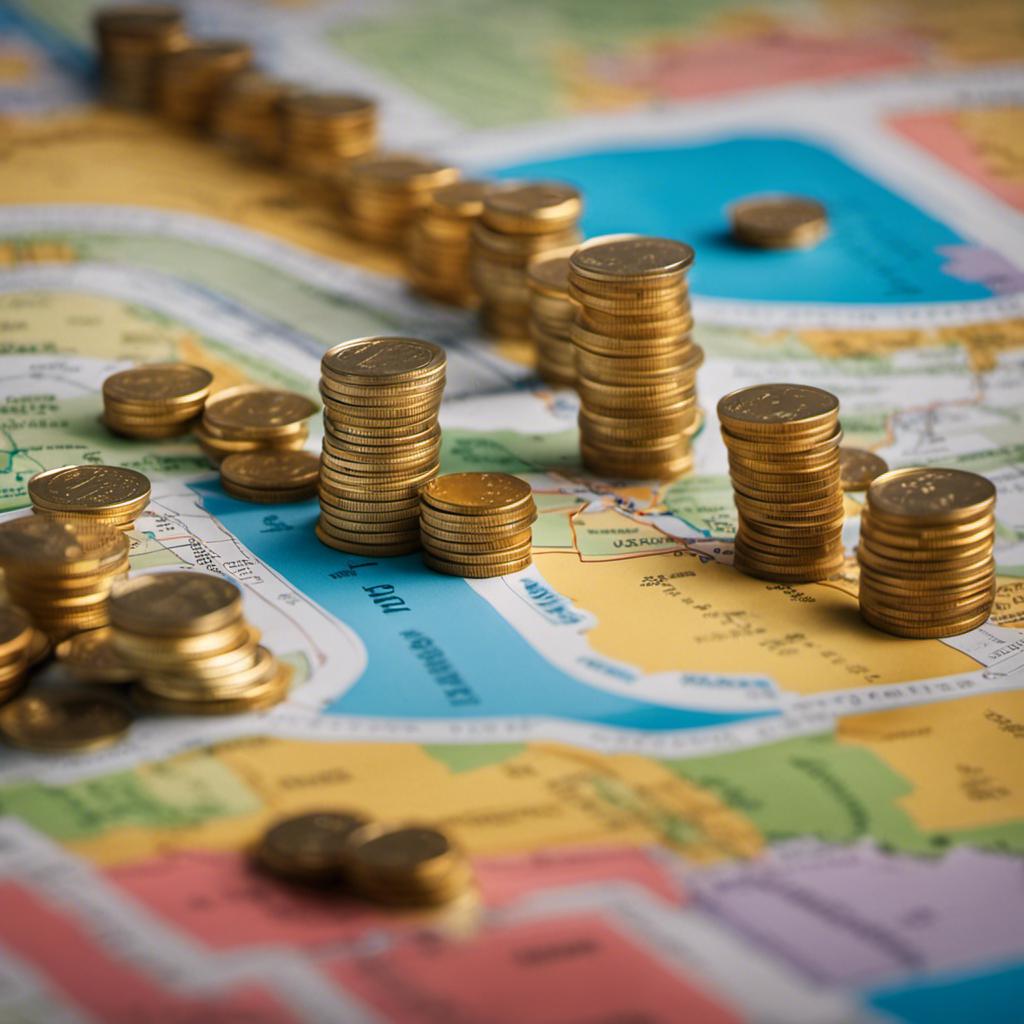Money Map
Are you tired of feeling lost and overwhelmed when it comes to managing your finances? Well, buckle up because money mapping is here to save the day! In this article, we’ll explore how money mapping can transform your financial journey. By creating a comprehensive plan for your money, setting specific goals, and tracking your progress, you’ll have the roadmap you need to navigate any twists and turns. Get ready to take control of your financial future with money mapping.
Key Takeaways
- Money mapping involves creating a roadmap for your finances, setting specific goals and timelines.
- It helps align your financial decisions with your long-term goals and allows for flexibility and adaptability.
- Money mapping requires continuous evaluation and adjustment, and having contingency plans for unexpected events.
- Automating investments can ensure consistent and disciplined saving, and should be included in your money map for better financial planning.
The Importance of Money Mapping

The importance of money mapping lies in its ability to provide you with a clear and organized roadmap for your financial journey. By creating a money map, you can reap numerous benefits and maximize the impact of your financial decisions. One key advantage of money mapping is its role in helping you develop financial resilience. Life is full of unexpected events, such as job loss or medical emergencies, that can derail your financial plans. However, with a well-crafted money map, you can develop strategies for overcoming these unexpected events and staying on track towards your goals.
Another way money mapping can benefit you is by enabling you to automate your investments. Automating investments is a smart strategy for consistent and disciplined saving. By setting up automatic contributions, you eliminate the need for manual effort and ensure that you are consistently saving towards your financial goals. This not only saves you time and effort but also allows your investments to grow over time.
Setting Financial Goals and Timelines

When setting financial goals and timelines, it’s important to be realistic and specific about what you want to achieve. To help you stay on track and make progress towards your financial goals, consider the following tips:
-
Financial goal setting: Clearly define your financial goals, whether it’s saving for a down payment on a house, starting a retirement fund, or paying off debt. Be specific about the amount you want to save or the deadline you want to meet.
-
Timeline planning: Create a timeline for achieving your financial goals. Break down larger goals into smaller milestones to make them more manageable. This will help you stay motivated and track your progress along the way.
-
Goal tracking: Regularly review and evaluate your progress towards your financial goals. Use tools like spreadsheets or apps to track your income, expenses, and savings. This will allow you to make adjustments if needed and stay accountable.
-
Automated investing: Consider setting up automatic investments to ensure consistent and disciplined saving. This can be particularly useful for long-term goals like retirement or education funds. By automating your investments, you can make progress towards your goals without having to manually contribute each time.
Visualizing Your Money Map

To gain a clearer understanding of your financial roadmap, it’s important to visualize your money map. Visualizing techniques and mapping tools can help you bring your financial goals and milestones to life. One effective technique is goal visualization, where you create a visual representation of your financial objectives. This could be a vision board or a digital visualization tool that allows you to see your goals in a tangible way.
In addition to goal visualization, tracking strategies are essential for visualizing your money map. By keeping track of your progress, you can see how far you’ve come and identify areas that need improvement. Mapping tools, such as spreadsheets or budgeting apps, can help you track your income, expenses, and savings over time.
Visualizing your money map not only helps you stay motivated, but it also allows you to make informed decisions about your financial future. By visualizing your financial milestones, you can set realistic goals and create a plan to achieve them. So, take the time to visualize your money map and use the right tools and techniques to track your progress towards financial success.
Prioritizing and Tracking Progress

Start by identifying your financial goals and creating a prioritized list to track your progress effectively. When it comes to prioritizing and tracking your financial progress, there are several key strategies you can implement:
-
Prioritizing milestones: Determine which financial milestones are most important to you and prioritize them accordingly. This will help you stay focused on what truly matters and ensure that you allocate your resources appropriately.
-
Tracking financial progress: Regularly monitor and measure your progress towards your financial goals. This can be done through tools such as budgeting apps or spreadsheets. By tracking your progress, you will be able to identify any areas that need improvement and make necessary adjustments.
-
Automation benefits: Take advantage of automation to streamline your finances. Set up automatic contributions to your savings and investment accounts. This not only ensures consistent and disciplined saving but also frees up your time and mental energy for other important tasks.
-
Setting investment goals: Define clear investment goals that align with your overall financial objectives. Whether it’s saving for retirement, buying a house, or funding your child’s education, setting specific investment goals will guide your investment decisions and help you stay on track.
-
Adapting to unexpected events: Life is full of surprises, so it’s important to be prepared for unexpected events that may impact your financial journey. Build flexibility into your money map and be willing to adjust your goals and plans as needed.
Organizing Your Money Map Chronologically

As you progress through your financial journey, it is important to organize your money map chronologically and with intentionality. By using organizing techniques and mapping milestones, you can effectively track your progress and set financial goals. Creating a chronological money map allows you to visualize your financial milestones in a clear and structured way. To help you get started, here is a table that you can use as a template for organizing your money map:
| Time Period | Financial Milestones |
|---|---|
| Month 1-6 | Build an emergency fund |
| Year 1-3 | Pay off high-interest debt |
| Year 3-5 | Save for a down payment on a house |
| Year 5-10 | Invest in retirement accounts |
Using this table, you can fill in the time periods and corresponding financial milestones that align with your personal goals. As you progress through each time period, you can check off the milestones you have achieved, keeping track of your progress along the way. This chronological approach to organizing your money map will help you stay focused and motivated as you work towards your financial objectives. Remember to regularly review and adjust your money map as needed to ensure that it remains aligned with your current financial situation and long-term goals.
Impact of Money Mapping on Various Aspects of Life

Take control of your finances and map out the impact it can have on different aspects of your life. Money mapping is not just about setting financial goals; it also affects your daily expenses, helps you plan for unexpected events, and allows you to anticipate major life events. Here’s how money mapping can make a difference:
-
Financial milestones: By mapping out your money, you can set specific and achievable financial milestones. Whether it’s saving for a down payment on a house or paying off debt, having clear goals will keep you focused and motivated.
-
Impact on daily expenses: Money mapping helps you become more mindful of your spending habits. By tracking your expenses and creating a budget, you can make informed decisions about where your money goes on a daily basis.
-
Planning for unexpected events: Life is full of surprises, and having a money map can help you prepare for the unexpected. By setting aside an emergency fund, you can handle unexpected expenses without derailing your financial progress.
-
Anticipating major life events: Money mapping allows you to plan for major life events, such as getting married, having a baby, or retiring. By mapping out your finances, you can ensure that you’re financially prepared for these milestones.
Incorporating money mapping into your financial routine also encourages consistent and disciplined saving. By automating your savings and investments, you can ensure that you’re consistently putting money towards your goals. So take the time to map out your money and see the positive impact it can have on various aspects of your life.
Aligning Financial Decisions With Long-Term Goals

Align your financial decisions with long-term goals by creating a comprehensive money map. Financial decision making strategies and goal-oriented financial planning are essential for long-term financial alignment. By strategically managing your money and making future-focused financial decisions, you can ensure that your actions today are in line with your desired outcomes tomorrow.
A money map serves as your guide, helping you prioritize and track your progress towards your financial objectives. It allows you to see the bigger picture and make informed choices that support your long-term goals. With a clear money map in place, you can make strategic financial decisions that align with your vision for the future.
By incorporating financial decision making strategies into your money map, you can ensure that each step you take is purposeful and moves you closer to your goals. This future-focused approach helps you stay on track and make choices that are in line with your long-term vision.
As you navigate your financial journey, remember that a money map is not set in stone. It requires flexibility and adaptability to respond to unexpected events and changes in circumstances. In the next section, we will explore the importance of flexibility and adaptability in money mapping and how it can contribute to your financial success.
Flexibility and Adaptability in Money Mapping

Stay flexible and adaptable in your money mapping journey to ensure success in achieving your financial goals. Being prepared for unexpected events and having alternative paths and contingency plans can help you navigate through any obstacles that may arise. Here are some important points to consider:
-
Flexibility and adaptability: Embrace the fact that your money mapping journey may not always go as planned. Be open to adjusting your goals and strategies when necessary.
-
Unexpected events: Life is full of surprises, both positive and negative. Prepare yourself for unexpected events by building an emergency fund and considering the potential impact of major life events on your financial goals.
-
Alternative paths: Just like a GPS, you can explore different routes to reach your destination. If your initial plan doesn’t work out, think creatively and find alternative paths that can still lead you towards your financial objectives.
-
Contingency plans: It’s important to have backup plans for different scenarios. Having contingency plans in place will help you stay on track even if things don’t go as expected.
In addition to flexibility and adaptability, incorporating automated investing into your money mapping can also contribute to your financial success. Automated investing allows for consistent and disciplined saving, eliminating the need for manual contributions. By setting up automatic investments based on your life stage and financial goals, you can ensure that you are consistently working towards your objectives.
Continuous Evaluation and Adjustment

Evaluate and adjust your financial plan continuously to ensure it remains aligned with your goals and circumstances. Continuous evaluation is essential for effective financial planning. By regularly monitoring progress and assessing the effectiveness of your strategies, you can make necessary adjustments to stay on track. Be flexible in your approach, as circumstances and priorities may change over time. Adapt your goals as needed to reflect new aspirations or unexpected challenges.
To facilitate continuous evaluation and adjustment, embrace flexible financial planning. This means being open to revisiting your money map and making revisions when necessary. Stay informed about changes in your financial situation and the broader economic landscape. Regularly review your budget, savings, and investment strategies to ensure they are still serving your needs. Consider seeking professional advice to gain fresh insights and perspectives.
Creating a Resilient and Adaptable Money Ecosystem

To build a strong and adaptable money ecosystem, you must diversify your investments. Creating a financial roadmap is essential for managing your financial risks and ensuring long-term stability. Anticipating potential threats allows you to be prepared and make informed decisions. Automating investments is a smart strategy to ensure consistent saving and disciplined financial habits. By setting up automatic contributions, you can eliminate the need for manual effort and stay on track with your financial goals. Diversifying income sources is another key aspect of creating a resilient money ecosystem. Relying on a single source of income can be risky, so exploring multiple streams of revenue can provide stability and flexibility. Managing financial risks is crucial to maintaining the health of your money ecosystem. This involves regularly evaluating your investments, adjusting your strategies, and being proactive in mitigating potential threats. By following these steps, you can create a resilient and adaptable money ecosystem that can withstand economic fluctuations and support your long-term financial well-being.
Frequently Asked Questions
How Can Money Mapping Help in Anticipating and Preparing for Unexpected Events?
Money mapping helps you anticipate and prepare for unexpected events by incorporating risk assessment into your financial planning. It allows you to proactively manage your money, prioritize goals, and create contingency plans for potential challenges.
What Are Some Examples of Alternative Paths or Routes That Can Be Explored in Money Mapping?
When money mapping, explore options like diversifying income through side hustles and creative investments. This helps with risk management and opens up alternative paths for financial growth.
How Can Contingency Plans Be Incorporated Into a Money Map?
Incorporate contingency strategies into your money map for financial preparedness. Plan for unexpected expenses and financial emergencies by setting aside a portion of your income for risk management and creating a safety net.
What Factors Should Be Considered When Determining When to Trigger Automated Investing?
Consider various factors when determining when to trigger automated investing, such as your financial goals, life stage, and risk tolerance. Timing plays a crucial role in decision making, allowing you to align your strategy with optimal opportunities.
How Can Automated Investing Milestones Enhance Financial Planning in Money Mapping?
Automated investing milestones enhance financial planning by streamlining the process. By incorporating strategies like portfolio diversification and risk management, you can align your investments with long-term wealth accumulation and achieve your financial goals.
Conclusion
Congratulations! You’ve just unlocked the secret to financial success with money mapping. With this powerful tool, you can navigate the twists and turns of your financial journey, prioritize your goals, and make informed decisions that align with your long-term vision. So, don’t wait any longer. Grab your money map and start paving the way to a future filled with financial stability, empowerment, and a whole lot of "cha-ching!"

